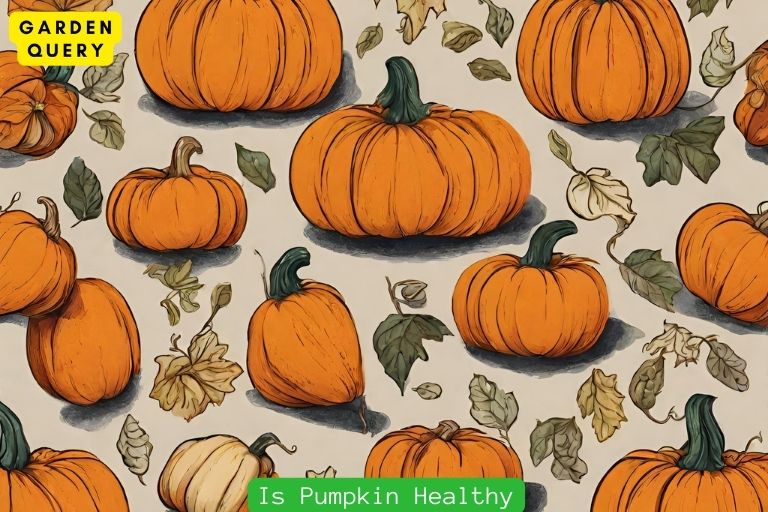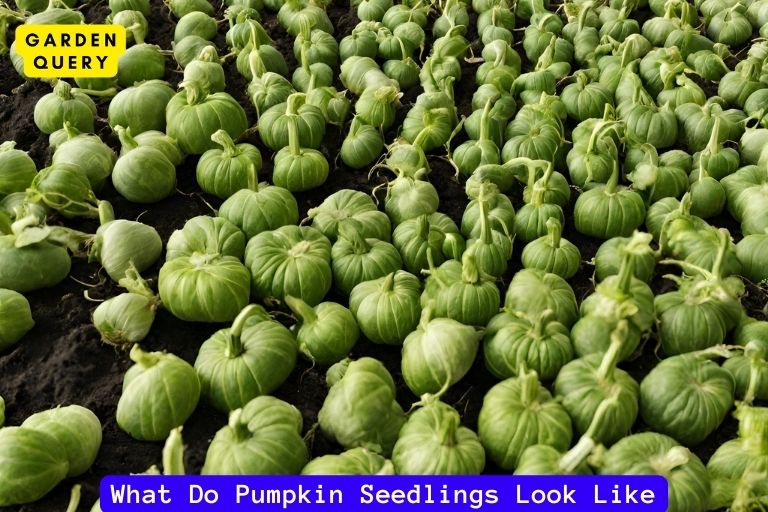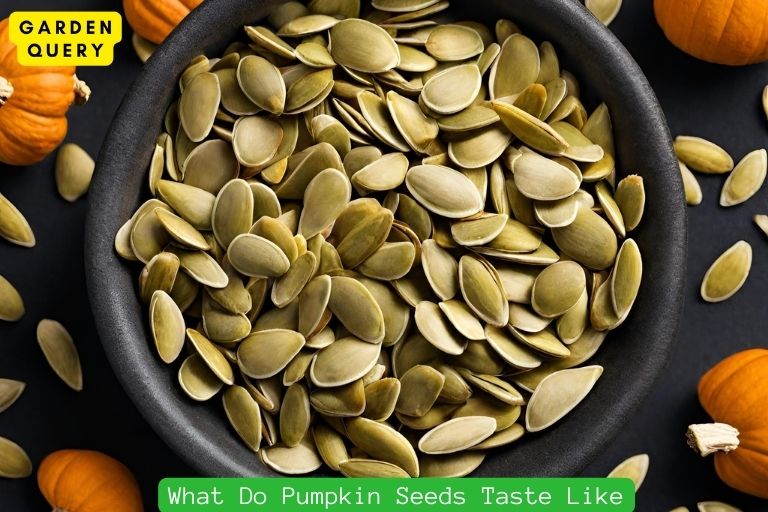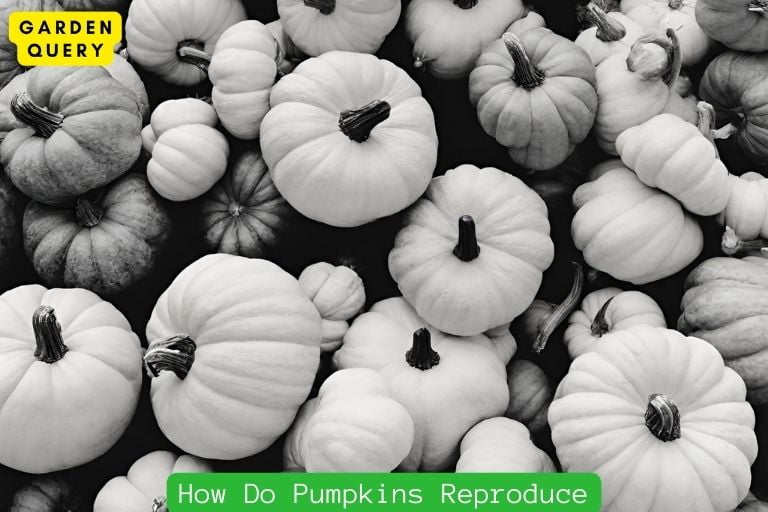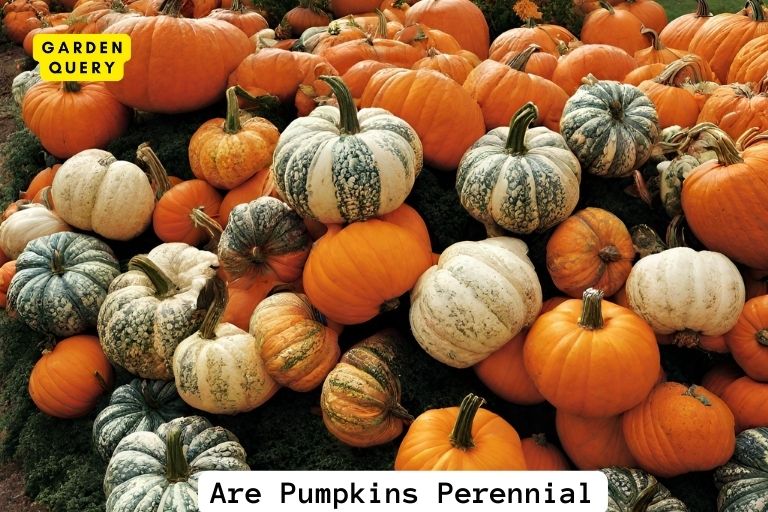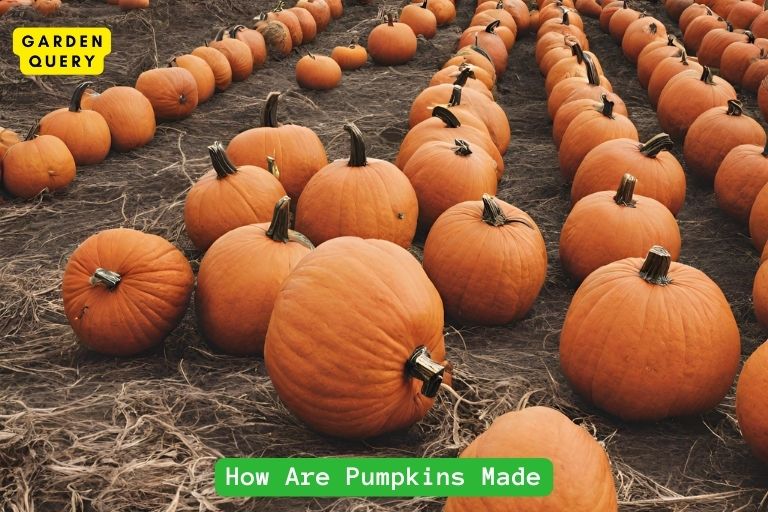How Are Pumpkins Harvested?
Pumpkins are typically harvested by cutting them from the vine, leaving a portion of the stem intact.
- Timing is Key: Pumpkin harvesting is an art that revolves around timing. The ideal time to harvest is when the pumpkin has reached full maturity, characterized by a deep, consistent color and a hard rind. This ensures that the pumpkin is ripe and will have the best flavor and storage potential.
- Stem Snipping Technique: Harvesting involves carefully cutting the pumpkin from the vine. It’s crucial to leave a portion of the stem attached to the pumpkin. This minimizes the risk of rot and extends the pumpkin’s shelf life. The stem acts as a protective barrier, preventing pathogens from entering through the cut.
- Hand Harvesting vs. Machinery: While smaller-scale farms often opt for hand harvesting, larger commercial operations may use machinery like pumpkin pickers. These machines gently lift the pumpkins from the vine, maintaining the integrity of both the fruit and the stem. Hand harvesting allows for a more selective approach, ensuring only fully mature pumpkins are picked.
- Curing for Longevity: After harvesting, pumpkins undergo a curing process, which involves exposing them to warm temperatures (80-85°F or 27-29°C) for about a week. Curing toughens the skin, heals small wounds from the harvest, and enhances flavor. Properly cured pumpkins can be stored for an extended period, making them available for both immediate use and long-term storage.
- Post-Harvest Handling: Once harvested and cured, pumpkins require careful handling. They should be stored in a cool, dry place, away from direct sunlight, to prevent premature decay. Inspecting for any signs of damage or disease during storage is crucial to maintain the quality of the harvested pumpkins.
Key Takeaway
Pumpkins Harvested
The Importance of Pumpkin Harvesting
Pumpkins are not only a symbol of fall but also a versatile and widely consumed fruit. From Pumpkin pie to jack-o’-lanterns, pumpkins have become an integral part of our seasonal celebrations. The harvesting process plays a crucial role in ensuring the availability of pumpkins for various purposes.
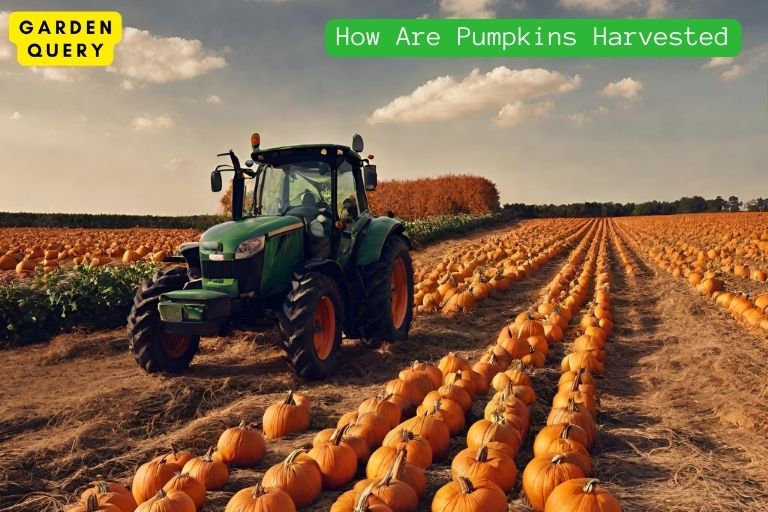
The Process of Pumpkin Harvesting
The process of harvesting pumpkins involves several key steps to ensure that the fruits are ripe, fresh, and ready to be enjoyed.
- Timing: Harvesting pumpkins requires careful timing. Pumpkins are typically ready for harvest when they have reached their mature color, which depends on the variety. Most common varieties like the Connecticut Field turn deep orange when fully ripe.
- Inspecting: Before harvesting, farmers inspect each pumpkin for signs of ripeness and quality. They look for a hard outer shell, a minimum size, and good color. Any pumpkins displaying signs of rot or damage are removed from the harvest.
- Cutting: Once the pumpkins have been inspected, they are carefully cut from the vine using a sharp knife or pruning shears. It is essential to leave a few inches of the stem attached to the pumpkin as it helps prolong the shelf life.
- Curing: After being cut, pumpkins are left in the field to cure in the sun for around ten days. Curing helps toughen the skin and improves the shelf life of the pumpkins.
- Storage: Once the curing process is complete, the pumpkins are moved to storage facilities. These facilities are designed to maintain proper temperature and humidity levels to prevent mold growth and extend the lifespan of the pumpkins.
- Transportation: Pumpkins are then transported to various markets and distribution centers to reach consumers. They are carefully packed to prevent damage during transportation to ensure that they stay fresh and intact.
Cultivating and harvesting pumpkins is not without its challenges. Farmers need to carefully manage pests, diseases, and weeds throughout the growing season. They also need to provide proper irrigation and fertilizer to ensure healthy plant growth. Harvesting machinery such as tractor-pulled wagons can be used to streamline the process on larger farms.
Pumpkin harvesting not only provides us with delicious treats and decorative items but is also an important economic activity for farmers around the world. The process requires attention to detail and proper timing to ensure that the pumpkins reach consumers in their best state.
In conclusion, the process of pumpkin harvesting involves careful inspection, cutting, curing, storage, and transportation. This ensures that the pumpkins are ripe, fresh, and ready for consumption or decoration. Farmers play a crucial role in growing and harvesting pumpkins, adding a touch of warmth and celebration to our lives during the autumn season.
Pre-Harvesting Stage
Pumpkin Planting and Growth
Before pumpkins can be harvested, they must go through a planting and growth stage. This begins with selecting the right pumpkin variety for your desired end use. There are various types of pumpkin varieties, each with their own unique characteristics and purposes. Common varieties include Jack-o’-lantern pumpkins, pie pumpkins, and novelty pumpkins.
Once the varieties have been chosen, it’s time to prepare the soil for planting. Pumpkins thrive in well-drained soil with a pH range of 6.0 to 7.5. The soil should be rich in organic matter and have good fertility. Farmers can test their soil to determine its nutrient content and make any necessary amendments. Proper soil preparation ensures the pumpkins have access to vital nutrients for healthy and vigorous growth.
Pumpkin seeds are typically sown directly into the soil in late spring or early summer, once the risk of frost has passed. The seeds are planted in hills or mounds, with each hill containing a few seeds. The hills are spaced several feet apart to allow the vines to spread. Pumpkin vines can grow up to 30 feet long, so they require ample space to flourish.
Pumpkin Varieties and Cultivation Techniques
Different pumpkin varieties have unique growth habits and cultivation techniques. For instance, large carving pumpkins require more space and tend to produce fewer fruits per vine, while smaller varieties such as sugar pumpkins can be grown in tighter spaces and yield more fruits.
Proper irrigation is crucial during the growth stage. Pumpkin plants require consistent moisture, especially during hot and dry periods. Drip irrigation systems that deliver water directly to the base of the plants are commonly used to ensure plants receive adequate hydration without wasting water.
Weed control is another important aspect of pumpkin cultivation. Weeds can compete with the plants for nutrients and water, stunting their growth. Farmers employ various methods to control weeds, including mulching between the rows to suppress weed growth and using herbicides sparingly and judiciously.
Throughout the growth stage, farmers monitor the plants for pests and diseases. Common pumpkin pests include aphids, squash bugs, and vine borers. If necessary, farmers may use organic or chemical insecticides to control these pests and protect the crop.
As the pumpkins mature, they change color and develop that iconic orange hue. This is a sign that they are ready for harvest. On average, it takes between 75 to 120 days from planting to harvest, depending on the variety.
Once the pumpkins have reached the desired maturity, they are carefully harvested by cutting the stem about 4 to 6 inches from the fruit. Special care is taken to avoid damaging the pumpkins during the harvesting process, as any bruises or cuts can shorten their shelf life.
In conclusion, the journey of a pumpkin from planting to harvest involves careful selection of varieties, proper soil preparation, irrigation, weed control, pest management, and patience as the pumpkins grow and mature. By following these steps, farmers ensure a bountiful harvest of vibrant and healthy pumpkins.
Signs of Readiness for Harvesting
As autumn rolls in and Halloween approaches, it’s time to start thinking about one of the season’s most iconic symbols – pumpkins. Whether you’re using them for decoration or creating delicious pumpkin treats, knowing when to harvest these vibrant orange orbs is essential for the best results. So, what are the signs that indicate a pumpkin is ready for picking? Let’s find out!
External Indicators for Harvesting
When it comes to determining the readiness of a pumpkin for harvesting, there are a few external indicators to look for:
- Color: The most obvious sign is the color of the pumpkin. A fully mature, ripe pumpkin will have a deep orange color. If the pumpkin is still green, it’s not yet ready for harvest.
- Hardness: Gently press your fingernail against the pumpkin’s skin. If it is hard and resists puncture, it’s a good indication that the pumpkin is ready to be picked. If it feels soft or squishy, it’s not yet ripe.
- Stem: Examine the stem of the pumpkin. A mature pumpkin will have a dry, brown stem. If the stem is still green and moist, the pumpkin needs more time to ripen.
Evaluating Internal Maturity of Pumpkins
While external indicators can give you a good idea of a pumpkin’s readiness, it’s also important to assess its internal maturity to ensure optimal flavor and shelf life. Here’s how you can check:
- Tap Test: Give the pumpkin a gentle tap with your knuckles. If it makes a hollow sound, it’s a good sign that the pumpkin is fully mature. A dull thud indicates that it may still be unripe.
- Weight: Pick up the pumpkin and feel its weight. A ripe pumpkin will feel heavy for its size. However, be cautious not to choose one that is too heavy, as it may be overripe and prone to rotting.
- Skin Thickness: Use your fingernail to gently scratch the skin of the pumpkin. If the skin is hard and resists scratching, it’s a sign of maturity. A softer skin may indicate an immature pumpkin.
Once you’ve determined that your pumpkins are ready for harvest, handle them with care to avoid any damage. Cut the stem about an inch away from the pumpkin, leaving a small portion attached to the fruit. This helps prevent decay from entering the pumpkin through the stem. Avoid lifting or carrying the pumpkin by its stem, as it may break off.
Harvesting pumpkins is an exciting time, whether you’re a farmer, gardener, or simply a pumpkin enthusiast. By keeping an eye out for the external and internal indicators of readiness, you can ensure that your pumpkins are picked at the perfect time for maximum flavor and longevity. So, get ready to enjoy the vibrant colors and delicious taste of freshly harvested pumpkins this autumn!
Harvesting Techniques
Pumpkins are a staple of fall and Halloween festivities, but have you ever wondered how they are harvested? There are two primary methods used for pumpkin harvesting: hand harvesting and mechanized harvesting.
Hand Harvesting Method
The hand harvesting method involves a team of workers carefully picking the pumpkins by hand from the vine. This is often done in smaller farms or instances where pumpkins are grown for niche markets. A skilled harvester will examine the pumpkin for ripeness, size, and quality before carefully cutting the stem.
One advantage of hand harvesting is that it allows for greater attention to detail. Harvesters can select only the highest quality pumpkins, ensuring a premium product for consumers. Additionally, hand harvesting minimizes damage to the pumpkins, as they are less likely to be bruised or punctured during the process.
However, hand harvesting can be labor-intensive and time-consuming. It requires a team of workers to manually pick each pumpkin, which can be a challenge for large-scale pumpkin farms. The cost of labor is also a consideration, as hand harvesting often requires a significant investment in manpower.
Mechanized Harvesting Method
The mechanized harvesting method, on the other hand, utilizes machinery to efficiently harvest pumpkins. This method is commonly used by larger commercial farms that produce pumpkins on a large scale.
Mechanized harvesting typically involves the use of specialized equipment, such as a pumpkin harvester. This machine is designed to carefully cut the pumpkin from the vine and remove the stem, all in one automated process. The harvested pumpkins are then collected and transported for further processing.
One advantage of mechanized harvesting is its efficiency. With the use of machinery, it is possible to harvest a large number of pumpkins in a relatively short amount of time. This allows for increased productivity and cost-saving benefits for pumpkin farmers.
However, mechanized harvesting may not always provide the same level of precision as hand harvesting. The machinery may not be able to differentiate between ripe and unripe pumpkins, resulting in a mix of different quality pumpkins. Additionally, there is a risk of damage to the pumpkins during the harvesting process, such as bruising or stem breakage.
In conclusion, both hand harvesting and mechanized harvesting methods have their advantages and disadvantages when it comes to harvesting pumpkins. Hand harvesting allows for greater attention to detail and premium quality selection, but can be labor-intensive and time-consuming. Mechanized harvesting offers efficiency and cost-saving benefits but may lack the precision and potentially cause damage to the pumpkins. The choice of harvesting method will depend on the size of the farm, the market demand, and the resources available to the pumpkin farmer. Overall, both methods contribute to the availability of pumpkins for consumers to enjoy during the fall season.
Post-Harvesting Process
After months of dedicated care and cultivation, the time has finally come to harvest the beautiful ripe pumpkins. But what happens next? In this article, we will explore the post-harvesting process of pumpkins and the techniques used to ensure their storage and preservation.
Cleaning and Sorting Pumpkins
Once the pumpkins are harvested from the fields, the first step is to clean them thoroughly. This involves removing any dirt, debris, or plant residue that may have accumulated during the harvesting process. The pumpkins are carefully scrubbed using soft brushes or dampened cloths to ensure their outer skins are clean and blemish-free.
After the cleaning process, the pumpkins go through a meticulous sorting procedure. The sorting helps in categorizing the pumpkins based on their size, shape, color, and overall quality. This step ensures that only the best pumpkins make it to the market, while any damaged or inferior ones are set aside for alternative uses, such as animal feed or composting.
Storage and Preservation Techniques
To maintain the freshness and longevity of the pumpkins, proper storage and preservation techniques are crucial. The ideal storage conditions for pumpkins include a cool, dry, and well-ventilated environment. This helps prevent mold, rot, and premature spoiling.
One commonly used preservation technique is curing. Curing involves placing the pumpkins in a warm, dry area for several weeks to toughen their skins and enhance their flavor. This process also aids in prolonging their shelf life. After curing, the pumpkins can be stored in a cool area, such as a basement or root cellar, where the temperature is consistently around 50 to 55 degrees Fahrenheit (10 to 13 degrees Celsius).
Another effective preservation technique is waxing. Many commercial pumpkin growers use food-grade wax to coat the pumpkins’ outer skin. The wax forms a protective layer that helps prevent moisture loss and slows down the decay process. This technique is widely used to extend the shelf life of pumpkins and keep them looking fresh and vibrant for an extended period.
In recent years, there has been an increasing interest in freezing pumpkin puree as a preservation method. Freezing helps maintain the flavor and texture of the pumpkins, making them perfect for baking delicious pies and other pumpkin-infused treats throughout the year. To freeze pumpkin puree, it is typically cooked, pureed, and then stored in airtight containers or freezer bags.
In conclusion, the post-harvesting process of pumpkins involves cleaning, sorting, and employing various storage and preservation techniques. By following these steps, growers can ensure that their pumpkins stay fresh, flavorful, and market-ready. Whether they end up on a doorstep as Halloween decorations or are transformed into delectable autumnal delights, the efforts put into post-harvesting are essential in delivering the best quality pumpkins to consumers
- Best Therapists In Dallas - February 1, 2024
- Holly Willoughby Husband: Holly Willoughby’s Love Story - January 30, 2024
- Holly Willoughby Dress: 5 Style Secrets and 7 Must-Know Career Milestones - January 30, 2024
